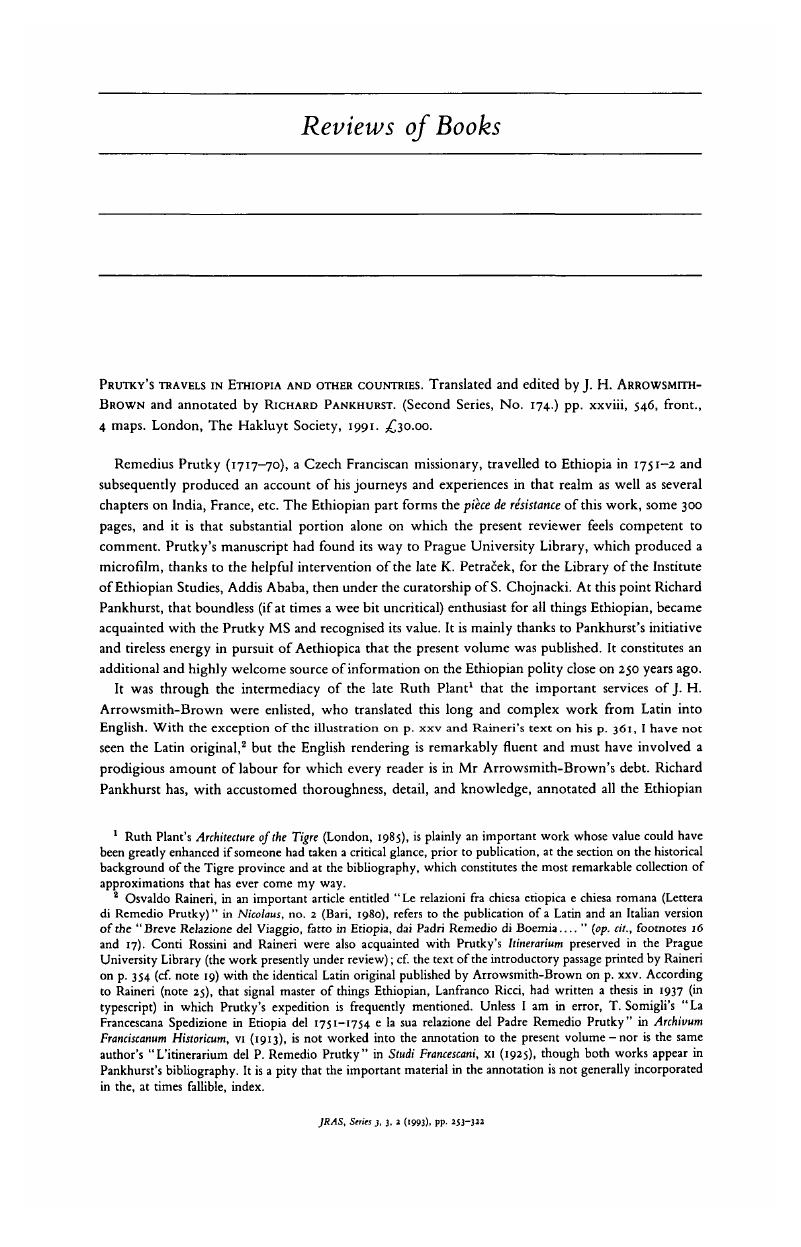No CrossRef data available.
Published online by Cambridge University Press: 24 September 2009

1 Plant, Ruth's Architecture of the Tigre (London, 1985)Google Scholar, is plainly an important work whose value could have been greatly enhanced if someone had taken a critical glance, prior to publication, at the section on the historical background of the Tigre province and at the bibliography, which constitutes the most remarkable collection of approximations that has ever come my way.
2 Osvaldo Raineri, in an important article entitled “Le relazioni fra chiesa etiopica e chiesa romana (Lettera di Remedio Prutky)” in Nicolaus, no. 2 (Bari, 1980)Google Scholar, refers to the publication of a Latin and an Italian version of the “Breve Relazione del Viaggio, fatto in Etiopia, dai Padri Remedio di Boemia… ” (op. cit., footnotes 16 and 17). Conti Rossini and Raineri were also acquainted with Prutky's Itinerarium preserved in the Prague University Library (the work presently under review); cf. the text of the introductory passage printed by Raineri on p. 354 (cf. note 19) with the identical Latin original published by Arrowsmith-Brown on p. xxv. According to Raineri (note 25), that signal master of things Ethiopian, Lanfranco Ricci, had written a thesis in 1937 (in typescript) in which Prutky's expedition is frequently mentioned. Unless I am in error, Somigli, T.'s “La Francescana Spedizione in Etiopia del 1751–1754 e la sua relazione del Padre Remedio Prutky” in Archivum Franciscanum Historicum, vi (1913)Google Scholar, is not worked into the annotation to the present volume – nor is the same author's “L’itinerarium del P. Remedio Prutky” in Studi Francescani, xi (1925)Google Scholar, though both works appear in Pankhurst–s bibliography. It is a pity that the important material in the annotation is not generally incorporated in the, at times fallible, index.
3 For Pankhurst's Metewwa (note (1) on p. 66) read Mәṣṣәwwa.
4 Raineri gives the date as “18 ottobre 1750” (op. cit. p. 352). The same author publishes the Latin text of several other letters by Emperor lyasu to which I can find no reference in the Hakluyt volume.
5 Cf. the Arabic and Amharic letters (in one case the same text appears in both languages) in The Amharic Letters of Emperor Theodore of Ethiopia to Queen Victoria and her Special Envoy (by Girma-Selassie, Appleyard, and Ullendorff), (London and Oxford, 1979)Google Scholar.
6 Cf. also Beccari, Rerum Aethiopicarum Scriptores Occidentales, vol. 1, pp. 64–5 and 224Google Scholar; vol. xiv, pp. vi–vii
7 Curiously the knowledgeable Raineri is misled, in his footnote 49, into observing “Così nel ms., per ‘Regis II Jasu1’ ”.
8 Pankhurst's version in footnote (i) on p. 320 has its problems, while Raineri's has some minor flaws and an absence of diacritics to which he has himself referred in note 44. Other attempts are not known to me, perhaps from ignorance.
9 Or mäl’akәt, a rarer form, but probably that underlying Prutky's perception; later on the Gә‘әz text shows plainly mäl’әkt.
10 This rather obvious word (corresponding to Amharic γәdräs in its usage) was erroneously omitted by Raineri; it has the strange, but just comprehensible, form “tebdech” in Prutky's text, and the wholly puzzling tasaddat in Pankhurst's annotation.
11 This form is odd, for as it stands it can only be the imperative of ’azzäzä (only attested as a I, 2 form; cf. Dillmann, Lexicon, col. 792) which in the present context is impossible. What is required is ‘ә’;ezzәz, i.e. “I the King…command”, the 1st pers. sg. impf. indicative. Prutky's and A-B's translations as “mando” and “enjoin”, respectively, are entirely correct in substance, though Raineri's explanation in note 46 is again puzzling, for his postulated a’azzәz could only be the subjunctive of a I, 2 form which the syntax of the present sentence does not admit.
12 Pankhurst's erroneous tahaseru is undoubtedly influenced by Raineri's tahaseru; neither makes sense, and it appears that Raineri was misled by the similar forms (often mixed up) of Ethiopic d and ṣ. Throughout the Ethiopic hand in Raineri, 360, d and ṣ are virtually indistinguishable (cf. tәbṣah, Dәbarwa, yәmäṣṣә’, etc.). Prutky, however, perceived the d sound correctly and translates correspondingly persistetis, followed by A-B's “remain” – happily uninfluenced by the otiose tahaseru in footnote I on p. 320.
13 Raineri's γemasa’e is an Unform induced by the lapsus calami of the Ethiopic letter ṣ, which should have been in the 6th vowel order instead of the first. Pankhurst should not have followed him in this slip. A precisely similar mishap occurred in the Ethiopic text further on, where we encounter wästä instead of wөstä.
14 “The Roman pontiff and archbishop”, but literally “the Roman chief and head of the bishops”: liq is not in the construct state liqä (though Prutky's “ Leicka ” suggests that he perceived the latter form) because several slat, constr. in conjunction are not admissible; in such instances the first noun remains either in the absolute state, e.g. länägäd wälähәzbä ’әsra’el (Jud. 18: 19) “to the tribe and people of Israel”, or other means of periphrasis are employed (see Dillmann, Ethiopic Grammar, para. 185, and Praetorius, Gramm. Aeth., para. 125).
15 Raineri appears to have failed to notice that “yehabkәmmu” is again an Unform (and Pankhurst follows him into this trap); it must be either indicative yәhubkәmmu “ he will give you ” or subjunctive yähäbkәmmu “ let him give you”.
16 Prutky transcribed, correctly, “czanta”, while Raineri (and Pankhurst in his footsteps) have the ungrammatical zәntä (in their transcription zenta).
17 Raineri's esme‘e (and similarly Pankhurst, though with ’ instead of the correct ‘) is not easily explained morphologically. Prutky's “esame” and the Gә‘әz original's clear ’әsämmә‘ (Raineri, 360) are quite acceptable, but ’asämmә‘ (II, I), in the sense of “bear witness, declare, affirm”, would patently be preferable.